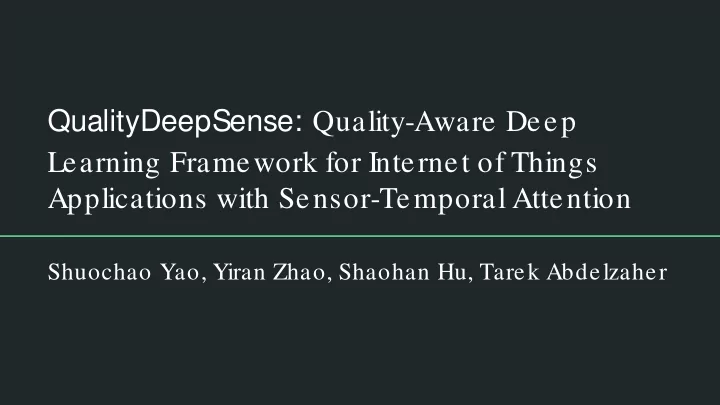

QualityDeepSense: Quality-Aware Deep Learning Framework for Internet of Things Applications with Sensor-Temporal Attention Shuochao Yao, Yiran Zhao, Shaohan Hu, Tarek Abdelzaher
DeepSense vs QualityDeepSense ● DeepSense ○ Unified neural network framework ○ Proved to be very good for mobile sensing and computing tasks ○ Does not consider noise/heterogenous qualily of the sensor data Solution!! ● QualityDeepSense ○ Modification of DeepSense to consider noise in the data ○ Uses sensor-temporal self-attention mechanism ○ Identify the qualities of input by calculating dependencies of their internal representation in DNN
Noise ● Low cost sensors ○ Insufficient accuracy, calibration & granularity ● Heavy multitasking & I/O workload ● May be due to other components of the system ● Noise do not determine the complex dependency between sensing inputs
Network Architecture
Data Flow ● Raw sensor data is divided across time for width t and a fourier transform is applied to each interval--Input of the network ● 3 Individual conv layers for extracting relations within a sensor ● Sensor Attention ● 3 Merge layers to extract relations between sensors ● RNN to extract temporal dependencies ● Temporal attention module ● Output (softmax)
Self -Attention ● Estimate sensing quality ○ Calculate internal dependencies ● Two steps ○ Calculate attention vector a ○ Weighted sum over rows using a ● To determine the dependencies among k-vectors
Evaluation ● Nexus-5 ○ 2.3GHz, 2GB memory, manually set to 1 .1 GHz ● TensorFlow-for-mobile ○ For DNN methods ○ Weka for SVM ● Dataset ○ 2-motion sensors-Accelerometer and gyroscope ○ 9 users with 6 activities (un-ordered) ○ Noise-augmented using white gaussian noise on either of time or frequency domain.
Accuracy Improvements
Effectiveness ● Attention ○ Multiplication of two attention modules ● Correlation b/w noise and Attention ○ Non-linear ○ Difference in sensing measurement ● Attention is small for strong noise
Execution time & Energy consumption
Overall ● QualityDeepSense performs better than DeepSense and is able to solve the heterogeneous quality sensing problem ● It shows lower performance degradation but with the expense of some execution time and energy consumption overhead ● There is no optimization done. Hyperparameter tuning & more network optimization can be done to reduce the overhead.
Recommend
More recommend